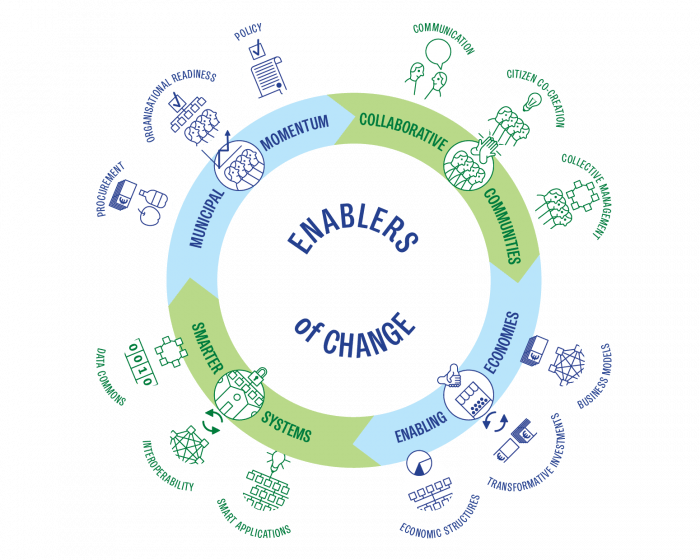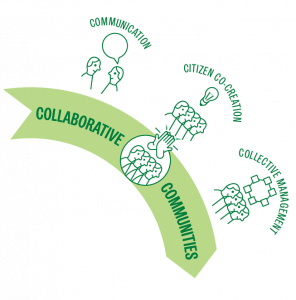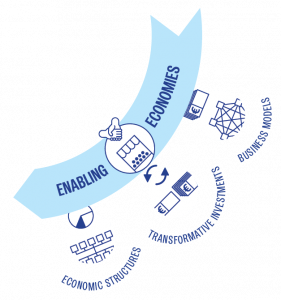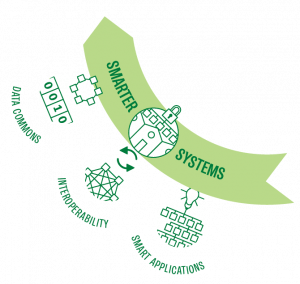Enablers of Change
Communities need to put a lot more work into ‘how’ to really make radical change happen in ways that benefit everyone.
Yet, we find that in most places the focus is mostly still on technically ‘what’ needs to change.
We know quite well what needs to change, but how things are done has a critical effect on whether change happens at all, and the ultimate community benefits of change. How to enable radical change is therefore a critical part of our approach.
For example, how a solar panel installation is developed has a huge bearing on its impact. Technically a system will generate the same amount of renewable energy, which is one benefit. But if, for instance, it is owned by a community co-operative that is citizen-financed then the financial returns will flow back to the community, building economic value over the system’s lifetime. If it is owned by a foreign corporation then these returns will disappear offshore. These things really matter and need careful consideration and planning. An elaboration of this example can be found in this conceptual story of Sončna Vas.
Enablers of Change

In summary this framework covers these four areas:
- Collaborative Communities: Collaboration across the community is a critical foundation for agreeing on goals and implementing the most effective ways of achieving them. How we work together and create collective value has to improve. It is also closely linked to regenerating our civic imagination capacity. Within this area we focus on communication, co-creation and collective management.
- Enabling Economies – Too often the economy is still considered an ends in itself, rather than a means to help us collaborate, prosper and live well. To turn the economy into an enabler of change and prosperity for all, we need to work on developing better business models, creating flows of transformative investment at the speed and scale really needed, and innovative economic structures.
- Smarter Systems – Data and digital technology can help us to create a better future, but we should remember that being ‘smart’ is an enabler rather than a goal in itself. Smarter community systems can be achieved using a combination of data commons and interoperability that together underpin smarter applications.
- Municipal Momentum – Government can use tools like public procurement and policy to accelerate action. How well government is organised and ready to help accelerate radical change is also a key enabler.
There are of course, a multitude of interconnections between these enablers, and organising them into four areas and 12 elements can suggest delineations where the reality is more complex. Nevertheless, this structure can provide a useful frame for thinking about the ‘how’ along with the ‘what’ when developing, designing, implementing and evaluating impactful change initiatives.
The four areas are further elaborated below.
Collaborative Communities
Communication
Communication is the foundation of collaboration. We have more communication tools than ever, and yet communities are increasingly struggling to communicate effectively between citizens, different social groups, organisations, businesses and governments. When communication fails, collaboration fails and conflicts grow.

Work is needed to develop improved and new forms of community communication that really enable people to meet, listen to each other, understand each other better, and thus modify their ideas and opinions. To start with it is valuable to explore creatively with different members of the community which communication means they mostly use, where they do feel heard, and where they do not feel represented – including an evaluation of local media channels. Based on this evaluation of the current communication context, plans can be developed for experiments and actions to develop more inclusive and representative places, spaces and tools for community communication that will help to build movements for positive change.
Citizen Co-creation
Co-creative processes are essential for designing missions, strategies, actions, management models and indicators for evaluating progress. Sporadic citizen engagement can never deliver the long-term participation and engagement needed to deliver radical change. The purpose of co-creation is not just to design specific outcomes. The goal must also be to strengthen and connect civic networks into a movement that provides an important foundation for change over time.
Co-creation needs processes that are fully inclusive and that really share long-term ownership of plans, designs, management and outcomes. There are many good practices that can be brought to this work such as citizen co-creation labs, citizen assemblies, civic city-monitoring, bottom-up policy labs, public service co-design, participatory campaigns and public space ‘placemaking’. A strong focus on youth involvement in co-creation processes is needed, as sustainable development is ultimately all about their future and often their voices are often not well heard in community development discussions, designs and decision-making. Civic co-creation is closely linked to work to regenerate civic imagination
Collective Management Structures
Communities need better models to collectively manage civic assets
long-term in ways that deliver maximum value to the community, better
prioritise equity and inclusiveness, and decentralise power and value as
much as possible. These models require an appropriate
collaboration, governance and resourcing model, with an appropriate
degree of formality.
Communities also need to find more effective models for collectively managing the process of mission led change, which we respond to with developing community Mission Incubator models.
In some cases, work on how to better collective asset management models will then evolve into the development of new Business Models under the Enabling Economies area, so these are closely linked. But it is important to first start with questions of how to manage civic assets collectively, and then establish appropriate business models where required.
Enabling Economies
Business Models
Sound business models are needed to enable successful project delivery, maximise the benefits to the community, secure investment and ensure equity and prosperity from community assets long-term. Where current models are not doing this, they need to be challenged, redesigned or replaced.

The wider impact of a technical ‘solution’ can be highly dependent on who builds, finances, owns and manages it. Different models make sense for different needs and actions, but often the breadth of possibilities are not carefully considered and presumptions are made about a preferred business model that then later undermines the success of the change that is trying to be achieved. When planning community actions, it is important to carefully consider what would be the implications of different business models in terms of costs to the community, where financial returns flow, investment, risk, efficient operation and environmental impacts.
Transformative Investment
A very critical enabler of mission-led change is the need for communities to harness financial investment a much greater speed and scale than they have managed before – generally billions of euros over the next decade.
While just one of the 12 enabler areas, we bring this out as one of the key parts of the Thriving Communities approach, because it is an area where we find every community is seeking urgent support. So, you can read more on how we tackle the Transformative Investment enabler area here.
Economic Structures
There is still a large disconnect in our communities between real social value and what is monetised in economic terms. There are significant issues relating to who gets to create and accrue money, and therefore gains a monopoly on deciding how to spend and invest it. There are gaping holes in taxation systems and who has to pay taxes, why and where. These structural economic issues are both a driver of inequality, and a handbrake on progressive action.
As a result, economic systems need to be reshaped to better enable scaling of transformational change activities and sharing of value over time. Innovations in the structural economic context that respond to these issues might include:
- Shifting taxes from good things like income and economic activity to problems like greenhouse gas emissions, pollution and excessive wealth.
- Stopping public subsidies for negative activities like fossil fuel extraction, and instead supporting mission innovation and beneficial activities like employing people and regenerating land, air and water resources.
- Universal basic incomes, shorter working weeks, and making volunteering a recognised/standardised economic activity.
- Local banking and local currencies.
- Supporting skills, entrepreneurship, connections and business growth to nurture new jobs and value chains in a local economy.
It is an interesting challenge finding ways for communities to take the initiative and creatively test and demonstrate innovative and better models in these areas. Where national governments are willing and able to be part of this process, then a lot more can be done faster.
Smarter Systems
Data Commons
Citizen-centric ownership and management approaches are needed to ensure that collective community data is made available in ways that safeguard privacy and fair value distribution. This builds the trust needed for useful data sharing. Development steps include 1) identifying what data a community has, and/or would like to have available to meet their needs; 2) designing how to make this data available to the community; and 3) deciding how data will be managed and governed as a community asset in commons.

Interoperability
Communities need to set standards for data systems that help to ensure efficient sharing and use of data across the community. Generally, communities will find that currently there are many different data ‘languages spoken’ by various existing devices and data platforms in their area. This undermines the potential value from integrating this data. If can be easily ‘translated’ into a common and easily accessible form that is ‘understood’ right across the community, then it can be made much more accessible.
Communities should therefore develop platform systems that allow multiple actors to share data from both existing and new sources, and make this data available for wide use and analysis. Such a system maximises opportunities for ‘smart application’ innovation and thus value-creation. Integration of such a platform with a ‘digital-twin’ representation of the community is a further opportunity to improve data access, usability and application potential.
Smart Applications
To actually use available data to help optimise strategies, information sharing, real-time guidance and operations management requires applications. With data made readily available through management in commons and interoperability standards, an almost infinite space for application development is opened up.
Development of applications aligned to priority use-cases is important, to avoid tech-for-tech’s sake. Use-cases should be mapped to what is needed for portfolio development and implementation. For example, applications can support improved future scenarios analysis and visualisation, operational efficiency, climate and disaster resilience, community co-creation processes, monitoring and measurement of progress. Applications can also support creative analytical approaches to plug gaps in conventional data sources.
Municipal Momentum
Procurement
Using public sector buying power is a key opportunity for government to nurture innovation and accelerate the investment flows and models needed for transformational change. In most contexts, where public investment goes, the local economy will follow. While often somewhat overlooked, large private sector organisations can also exert similar market influence, ideally in partnership/alignment with local government.

Public sector procurement actors need be supported through capacity development to understand opportunities connected to whole-of-life costing, ecological footprints, and internalising ‘externality’ costs in the current economic system that are real costs to their community. The goal is to encourage them to be more innovative in how they use procurement processes to support community missions.
Policy
Local government policies can and must play a critical role in enabling change. Improvements are needed in strategic policy, spatial planning and local regulations. When done well, these help to accelerate innovative actions, enable new business models, reduce risk for capital partners, ensure transparency and influence necessary behaviour changes. Often community actors still see local policies more as barriers rather than enablers, and this must be changed.
Traditionally, policymaking has been characterised as a rational process involving a linear path from problem definition to the analysis of options and development of policy solutions. Increasingly, this view is being contested due to the inherent complexities facing the public sector. In complex systems, well‐intended interventions often have unintended consequences. Co-creative policy development processes are needed to ensure early engagement with stakeholders and to transcend organisational and procedural silos. In the end, changing policy practices and implementation can matter as much as changing written policies and legislation. Policy innovation labs can be facilitated as an approach for nurturing this shift in policy approach.
Organisational Readiness
Most municipalities today are not set up, or sufficiently empowered, to nimbly drive transformative action in their communities. Municipalities need to consider how they can reprioritise and reorganise their governance, human resources and decision-making processes to play the strongest leadership role they can, while also supporting wider cross-community leadership, organising and management models. This links closely to the role that Local Government will play in the Mission Incubator models, in which municipalities may be more or less involved depending on what suits different communities.
In our work with communities we focus on local government, but of course other layers of government also have a critical role to play and will also need reorganising to effectively support radical change.
This thinking on enablers of change underpins many parts of our overall approach, and it is key that communities bring this into their change process management and portfolio development and management work.

